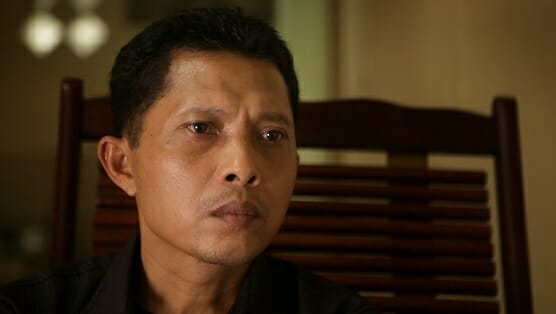The Look of Silence

The Look of Silence is the companion piece to director Joshua Oppenheimer’s 2012 Academy Award-nominated documentary, The Act of Killing,which examined the Indonesian genocide of 1965-66 through interviews and on-camera recreations by the military perpetrators. This time around, the film focuses on a family of survivors whose youngest son seeks the truth of his brother’s death during the culling.
While the first film was more visually inventive and, to an extent, playful, The Look of Silence, with its straightforward storytelling, is devastatingly powerful. The film is an elegiac and beautiful—yet horrifying—work. Numerous moments feel like a kick in the gut. (There’s no roundabout way to describe the visceral reaction to its imagery and dialogue.) If The Act of Killing didn’t convince audiences of Oppenheimer’s mastery as a filmmaker and documentarian, then The Look of Silence surely will.
Oppenheimer makes no pretense to remain objective. The film is a damning critique of the mass murderers of more than 1 million people who were deemed “communists” or intellectuals. In other words, the military gangs that rose to power exterminated anyone who dared oppose them.
The film introduces audiences to Adi, an optometrist, born after the killings. His mother Rohani and his invalid father Rukun (both centenarians) lost a son, Ramli, in the genocide. Rohani tells Adi that she and Rukun rejoiced at his birth because he was Ramli’s replacement and their reason to continue living. This birthright would be difficult for anyone to bear, but rather than a burden, the ghost of the elder brother he never met proves to be a badge of courage, empowering Adi to seek the truth. Ramli is a martyr, a symbol for victims whose stories are never told or remain unknown.
The film opens with a haunting close-up of an older man in odd glasses. The colorful specs turn out to be Adi’s instrument that tests patients’ eyes, and the man wearing the glasses is one of the death squad leaders. It’s a scene that recurs throughout the film—Oppenheimer’s use of stunning color and repetitive shots creates a beautiful backdrop, or a palate cleanser, for the horrific subject matter. Adi meets with the men responsible for his brother’s death under the guise of a medical appointment. Like Anwar Congo, the main character in The Act of Killing, the perpetrators are open to being filmed while answering questions from Adi or Oppenheimer. In fact, many of the men are only too gleeful, happy to take center stage on camera, boasting about their murderous exploits. It’s nearly unfathomable.
-

-

-

-

-

-

-

-

-

-

-

-

-

-

-

-

-

-

-

-

-

-

-

-

-

-

-

-

-

-

-

-

-

-

-

-

-

-

-

-








































